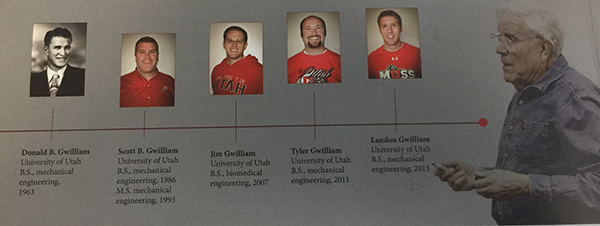On April 19, University of Utah mechanical engineering Distinguished Professor K.L. DeVries (Larry) stepped in front of a group of students for one last time (video – ME EN 2030 Dynamics class review, April 19, 2017).
It was the final class of his illustrious 55-year career teaching generations of bright problem solvers at the U.
“I always liked the variety, and I liked working with the students,” he said about what kept him energized year after year. “It was the excitement that brought me back every day.”
If he wasn’t lecturing in front of students, DeVries often could be found in his office in the Rio Tinto Kennecott Mechanical Engineering Building grading assignments and tests. His tests, which he grades by hand, always find their way back to the students the very next class period.
He didn’t start out wanting to be a professor. In fact, it was a series of fortunate, well-deserved events that carried DeVries to where he is today. As an undergraduate, he took a job conducting a literature search on high-pressure mechanics, resulting not only in a B.S. thesis, but a 495-page technical report (with nearly 500 hand-drawn figures) that was published by the Air Force Office of Scientific Research. This report formed the foundation of his Ph.D. dissertation on “Creep at High Pressures,” launching his career in solid mechanics.
Born in 1933, DeVries grew up on a farm just outside of Ogden. He remembers growing up on the same street as famous Utahans, John Willard Marriott and Tracy Hall.
DeVries earned his bachelor’s in mechanical engineering in 1959 and a doctorate in physics and mechanical engineering in 1962, both from the University of Utah. He joined the mechanical engineering faculty at the U that same year.
“It was a private conversation with a Russian scientist at a conference in Japan that led to the characterization of the molecular phenomena of fracture in my Fracture and Adhesives Laboratory here at the U, and which resulted in an exciting time as anything we did was new and novel in our field,” he said about his research. “Plus, a grant to evaluate barnacle cement as a potential dental adhesive led to over 30 years of funded adhesive research.”
Having served in several different positions, including as assistant professor in the early ’60s and senior associate dean of the College of Engineering in the late ’90s, DeVries is now recognized as a distinguished professor. He has taught both the advanced and undergraduate levels of strength of materials.
Throughout his life, DeVries had the opportunity to travel across the world, lecturing in India, Europe, Japan, and throughout the United States. Meanwhile, he performed consulting work abroad for mainstream corporations such as 3M and Emerson Electric. “Some of these companies tried to hire me full time, but I really liked what I was doing,” he said.
DeVries’ office is adorned with plaques and certificates of his many awards and recognitions. He has earned the Calvin S. and JeNeal N. Hatch Prize in Teaching, the 1996 Professor of the Year award, the 1993 Utah Governor’s Medal for Science and Technology, and several other distinctions by organizations across the nation.
Although he has been recognized for his achievements, DeVries said his favorite memories include seeing students graduate and progress. His students have published about 100 theses and dissertations. “Every time I graduate a student, I feel a certain amount of pride,” he said.
In his five-decade career, he has adapted to every new technology presented to him, including items that today’s students might find trivial, such as a calculator or a computer. Aside from the technology, DeVries said the field as a whole has changed and expanded tremendously. He also noted the sophistication and preparation of students has gone up since he started in the ’60s.
DeVries has had season tickets to football games ever since he started. He currently holds front-row seats for himself and his family and enjoys watching football, basketball, gymnastics and other Ute sports with his children and grandchildren.
“I’m a Ute through and through,” he said.
